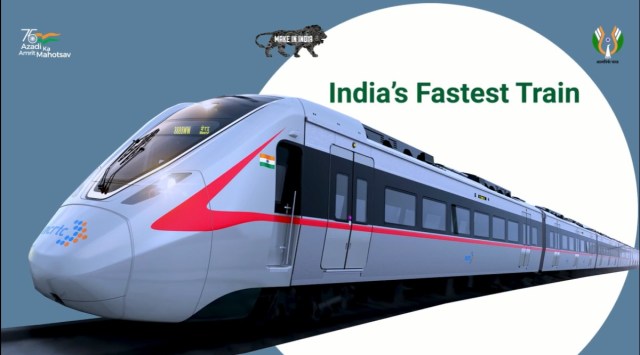India’s first rapid rail unveiled, promises Delhi to Meerut in 55 minutes
The trains will have standard as well as one premium or business car per train, along with one coach reserved for women.
 RRTS) train will run on the Delhi-Ghaziabad-Meerut corridor and cover a distance of 82 km in just 55 minutes. (Photo: NCRTC)
RRTS) train will run on the Delhi-Ghaziabad-Meerut corridor and cover a distance of 82 km in just 55 minutes. (Photo: NCRTC)Cushioned seats, overhead luggage racks, more standing space and a ‘premium’ section – these are some of the swanky features inside coaches that are to be part of India’s first rapid rail, unveiled by the National Capital Regional Transport Corporation (NCRTC) on Wednesday.
🗞️ Subscribe Now: Get Express Premium to access the best Election reporting and analysis 🗞️
The Regional Rapid Transit System (RRTS) train will run on the Delhi-Ghaziabad-Meerut corridor and cover a distance of 82 km in just 55 minutes. It will also be the first in the country to have a business or ‘premium’ coach on a regional corridor.
Discussing its modern and commuter-friendly features, NCRTC managing director Vinay Kumar said, “Since the inception of the RRTS project, commuter convenience has been our priority. The entire infrastructure, be it trains or stations, have been designed to ensure safety, ease of access, and comfort for commuters so that it will become the people’s first choice.”
Features
The upcoming RRTS trains will have 2×2 transverse seating, wide standing space, overhead luggage racks, CCTV cameras, sockets at every seat for laptop/mobile charging, dynamic route maps, auto control ambient lighting system, heating ventilation and air conditioning (HVAC) system, and other amenities.
The trains will have standard as well as one premium or business car per train, along with one coach reserved for women. The premium coach has reclining seats with more legroom, coat hangers and a vending machine facility.
A separate business section is also being built on the concourse level at the platforms, which will have a separate automatic fare collection system, and entry and exit.
 Delhi Metro trains, these have an aerodynamic profile with a long nose and plug-in-doors to reduce air drag at higher speeds. (Express photo)
Delhi Metro trains, these have an aerodynamic profile with a long nose and plug-in-doors to reduce air drag at higher speeds. (Express photo)
Unlike Delhi Metro trains, these have an aerodynamic profile with a long nose and plug-in-doors to reduce air drag at higher speeds. The coaches have three doors for entry and exit, are fully air-conditioned and have wide gangways. While the trains are automated, train operators will be present inside to oversee operations.
At the start, the RRTS corridor will run six-coach trains. Nine-coach trains will be added once the entire stretch is ready. Commuters will get trains at a frequency of 5-15 minutes and can cover the distance between Delhi and Meerut in 55 minutes with 14 stops.
Trial run this year
Singh said the trains are being manufactured at the Savli plant in Gujarat and a trial run on the tracks will start from May. “A full speed trial will be done from December. All these train sets are being manufactured in India under ‘Make in India’ guidelines,” he said.
NCRTC officials said 210 cars will be delivered by the end of this year for the Delhi-Meerut RRTS Corridor including train sets for operating regional transit services on the Delhi-Ghaziabad-Meerut corridor and for local transit services in Meerut. NCRTC will also construct Metro stations on the same stretch to provide local connectivity to the people of Meerut. Both metro and rapid rail will run on precast high-tech ballastless tracks.
 NCRTC is also envisioning starting commercial logistics and cargo services on the corridor after service hours. (Express photo)
NCRTC is also envisioning starting commercial logistics and cargo services on the corridor after service hours. (Express photo)
The NCRTC MD said the train will also provide a green corridor for emergency services. “Currently, if a patient or an organ is to be transported, a green corridor is created on the road. The RRTS will provide a green corridor for emergency service and patients can reach a hospital in an hour for around just Rs 100.”
The department is yet to fix ticket prices. A discussion will take place on this soon, said officials. However, it will introduce a ‘One Card One Nation’ system for ticketing.
NCRTC is also envisioning starting commercial logistics and cargo services on the corridor after service hours. The corridor is further expected to cut 2,50,000 tonnes of carbon dioxide emissions per year and shift 2 lakh private vehicles users to public transport.
The corridor will have 25 stations, including two depots at Duhai and Modipuram and one stabling yard at Jangpura. 90% work is completed on the 17-km priority section between Sahibabad and Duhai and it is expected to be inaugurated by 2023. It will have five stations – Sahibabad, Ghaziabad, Guldhar, Duhai, and Duhai Depot. The estimated daily ridership is around 8 lakh passengers. The entire corridor is expected to be ready by 2025.







